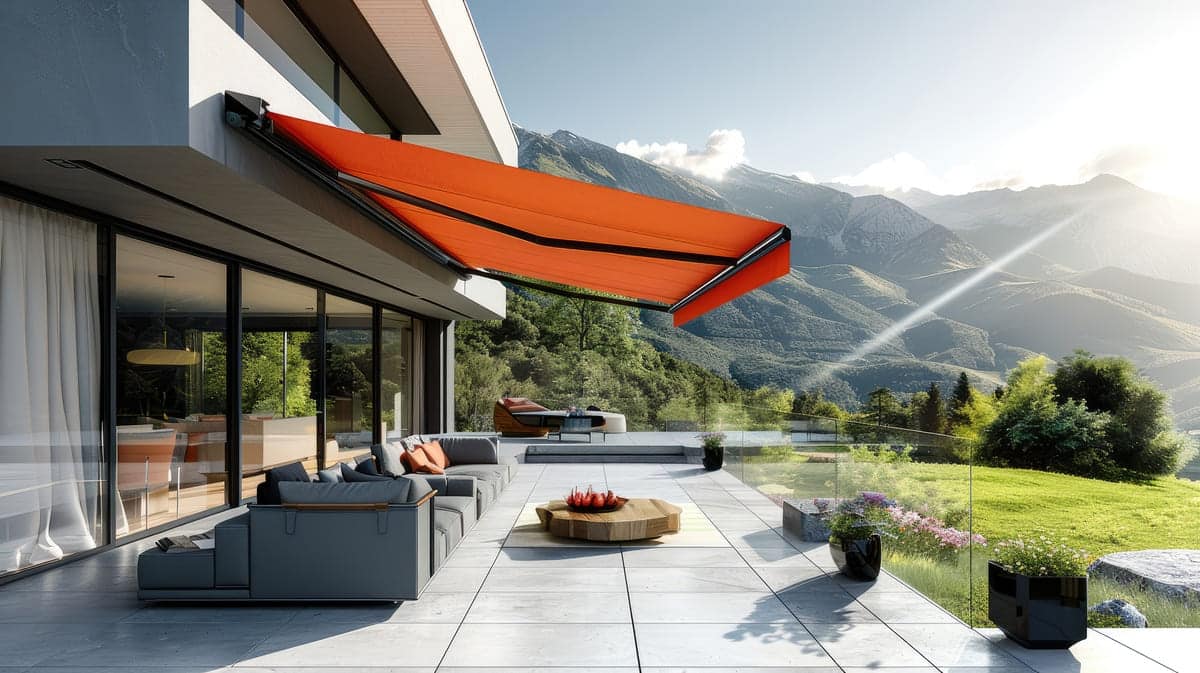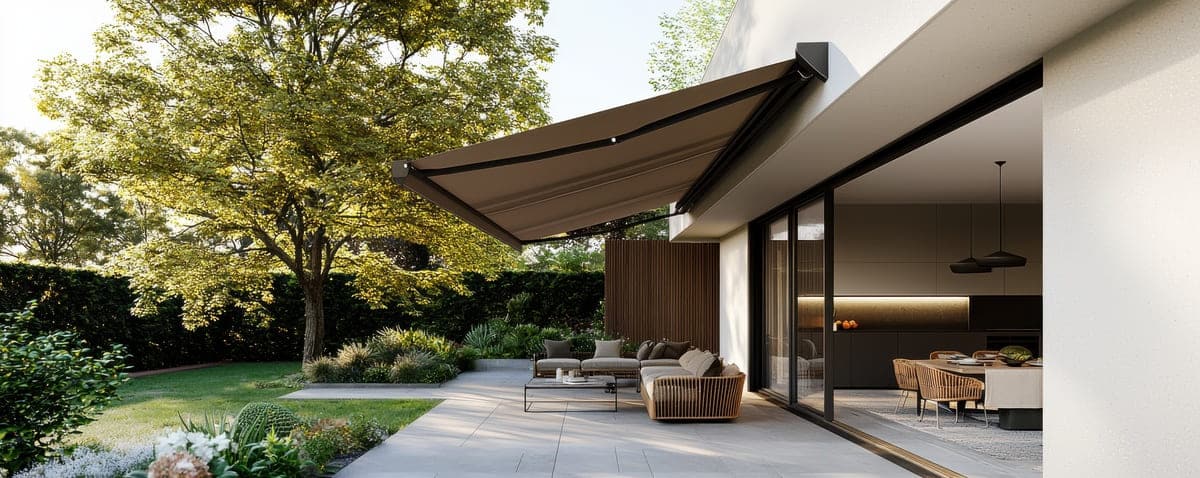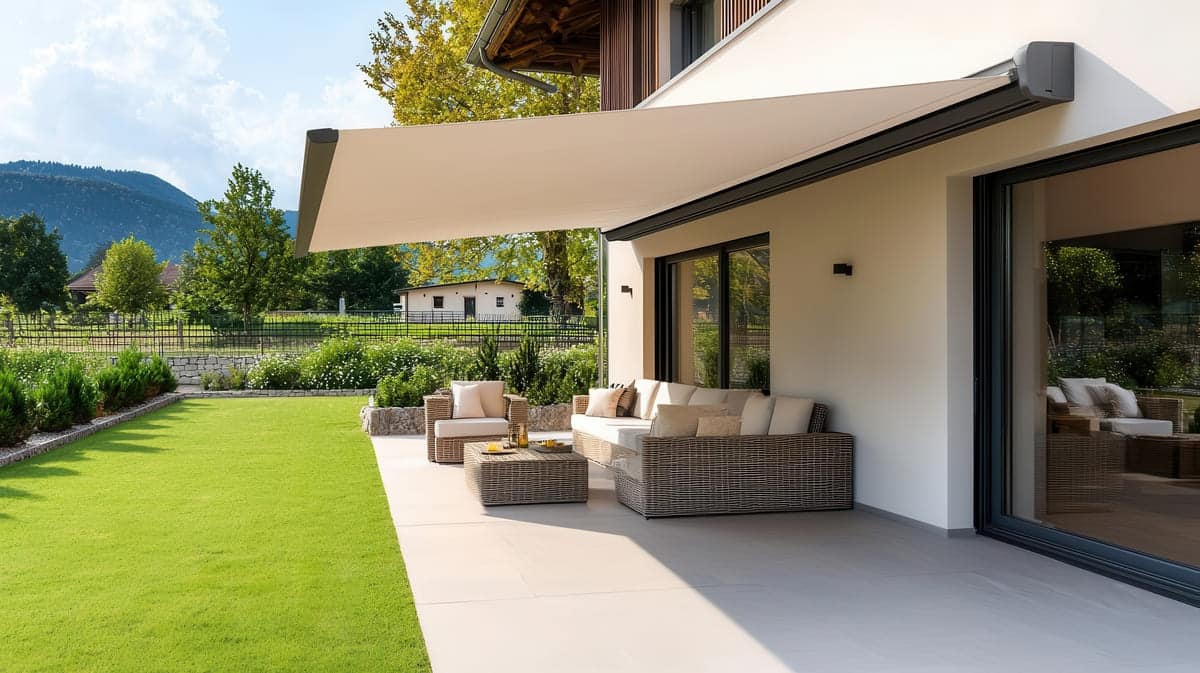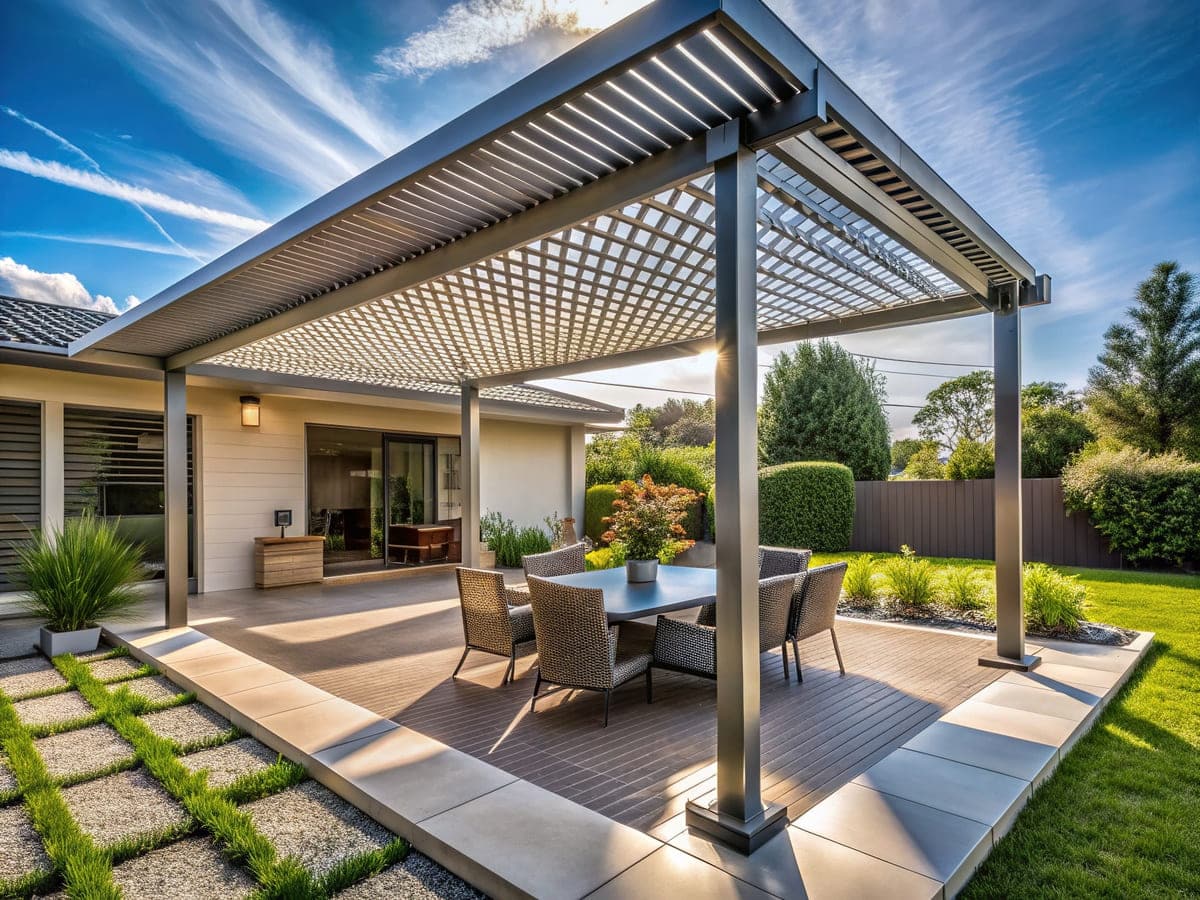Discover the Versatility of Freestanding Awnings
Freestanding awnings redefine outdoor living by offering unmatched flexibility and aesthetic appeal. Unlike traditional models that require structural attachment, these awnings stand independently, making them ideal for diverse garden settings. This adaptability allows you to create shaded retreats without altering existing architecture.
Key Features and Benefits
- Adaptable Design: Freestanding awnings seamlessly integrate into various garden layouts, providing shade precisely where needed. Their mobility ensures optimal comfort as the sun moves throughout the day.
- Robust and Low Maintenance: Crafted from durable materials, these awnings withstand the elements, offering long-lasting protection with minimal upkeep. Their weather-resistant fabrics and sturdy frames ensure reliability across all seasons.
- Enhanced Outdoor Experience: By creating distinct zones for relaxation or dining, freestanding awnings transform gardens into functional outdoor retreats. They blend style with practicality, enhancing both the aesthetic and usability of your space.
Distinct Advantages Over Traditional Awnings
Freestanding awnings offer unique advantages over traditional counterparts. While fixed awnings require structural support, freestanding models provide the freedom to design your outdoor space without constraints. This flexibility is perfect for areas where building attachment isn’t feasible or desired.
Our Expertise at The Outdoor Living Group
At The Outdoor Living Group, we specialise in crafting bespoke freestanding awning solutions tailored to your garden’s unique needs. Our expert consultants collaborate with you to design and instal the perfect awning, ensuring it complements your outdoor environment. Explore our range and book a consultation to discover how we can transform your garden into a versatile, stylish retreat.
What Are the Advantages of Using Freestanding Awnings?
Freestanding awnings redefine garden spaces, offering unparalleled flexibility and visual enhancement. Unlike traditional models, these awnings stand independently, allowing creative freedom in design and placement.
Practical Benefits
- Flexible Placement: Position freestanding awnings anywhere in your garden to provide shade without structural attachment. This adaptability is perfect for creating shaded retreats that move with the sun.
- Weather Protection: Enjoy robust protection against sun, rain, and wind, ensuring your outdoor space remains usable in various conditions. Their durable construction requires minimal maintenance, making them ideal for long-term use.
Aesthetic Enhancements
- Visual Appeal: With sleek designs and customizable options, freestanding awnings elevate the visual appeal of any garden. Tailor them to match your garden’s aesthetic, creating a cohesive and inviting outdoor environment.
- Distinct Zones: Define areas for dining or relaxation, contributing to a well-organised garden layout that enhances both functionality and style.
Versatility and Flexibility
- Repositionable Design: Easily move freestanding awnings to accommodate changing sun angles or seasonal needs, offering unmatched versatility. Their modular design supports expansion, ideal for evolving garden spaces.
- Independence from Structures: These awnings do not rely on existing buildings for support, making them suitable for areas where structural attachment isn’t feasible or desired.
Freestanding awnings not only enhance the aesthetic and practical aspects of garden spaces but also significantly contribute to outdoor comfort and usability, creating inviting environments that can be enjoyed year-round.

Types of Freestanding Awnings
Freestanding awnings offer versatile solutions for enhancing outdoor spaces, each type bringing unique features and benefits. Understanding these variations helps tailor choices to specific garden needs.
Explore Freestanding Awning Varieties
- Retractable Awnings: These versatile awnings offer flexibility, allowing you to adjust for sun or shade as needed. Ideal for dynamic spaces, they can be retracted to enjoy open skies or extended for protection. Their motorised or manual operation integrates seamlessly with smart home systems, enhancing user control.
- Fixed Awnings: Known for their stability, fixed awnings provide a permanent solution, perfect for creating enduring outdoor areas like dining spaces. Built with durable materials, they withstand various weather conditions, offering reliable shelter and complementing existing architecture.
- Modular Awnings: Designed for adaptability, modular awnings allow for expansions or reconfigurations. They are ideal for evolving garden landscapes, offering a customizable approach to outdoor shading. These awnings provide flexibility in design, allowing for personalised layouts that suit specific needs.
Choosing the Right Awning for Your Garden
- Garden Size and Layout: Consider the available space and how the awning will fit within the garden’s design. Freestanding awnings can be positioned anywhere, offering shade without structural attachment.
- Intended Use: Determine whether the space will be used for dining, relaxation, or entertainment, influencing the type of awning chosen. Each awning type offers distinct advantages for different activities.
- Climate and Weather: Evaluate the local climate to ensure the awning materials and design can withstand environmental conditions. Durable construction ensures long-term use with minimal maintenance.
Freestanding awnings not only enhance the aesthetic and practical aspects of garden spaces but also contribute significantly to outdoor comfort and usability, creating inviting environments that can be enjoyed year-round.
How Can Freestanding Awnings Enhance Garden Design?
Freestanding awnings bring a transformative touch to garden spaces, merging functionality with aesthetic charm. These versatile elements integrate seamlessly into various garden designs, enhancing usability and visual appeal.
Creative Integration of Awnings
- Define Distinct Zones: Use freestanding awnings to create specific areas like dining or relaxation spots without permanent structures. This flexibility allows for seasonal adjustments and varied uses throughout the year.
- Seamless Blending: Incorporate awnings with existing garden features such as pergolas or water elements, creating a cohesive and harmonious outdoor environment. This integration enhances the overall design, making the garden feel more expansive and inviting.
Popular Design Trends
- Minimalist and Biophilic Styles: Current trends favour clean lines and natural materials, with awnings that complement the garden’s organic elements. This approach enhances aesthetic appeal and promotes sustainability by using eco-friendly materials.
- Focal Points: Awnings can serve as striking focal points, drawing attention and adding elegance to the garden. Their presence elevates the space, making it more inviting and visually interesting.
Personalising Awning Setups
- Unique Customizations: Personalise your awning with distinctive fabric patterns and colours that reflect your style. Consider integrating smart technologies for added convenience, such as remote-controlled adjustments or weather sensors.
- Harmonious Design: Ensure your awning complements the garden’s overall theme, maintaining a consistent and pleasing aesthetic. This alignment enhances the garden’s ambiance, making it a more enjoyable space for relaxation and entertainment.
Freestanding awnings not only provide practical benefits but also significantly contribute to the garden’s theme and ambiance, creating a welcoming and aesthetically pleasing environment.
How to Instal and Maintain Freestanding Awnings?
Key Steps for Installation
Installing freestanding awnings enhances your garden’s elegance and flexibility. Begin by preparing a level, obstruction-free site. Secure the structure with concrete pads or anchors for stability.
- Frame Assembly: Follow detailed instructions to ensure all components align securely.
- Canopy Attachment: Maintain tension for wind resistance and aesthetic alignment.
- Final Adjustments: Test functionality, making necessary tweaks for smooth operation.
Ensuring Longevity and Performance
Choose weather-resistant fabrics and corrosion-proof frames to endure environmental challenges. Regular inspections help identify wear early, allowing for prompt repairs. Use UV protectants and waterproof coatings to extend your awning’s lifespan.
Recommended Maintenance Practices
Establish a cleaning routine using mild soap and water, avoiding harsh chemicals. Regularly lubricate moving parts to prevent rust and ensure smooth operation. Adjust tension and alignment with seasonal changes for optimal performance.
Enhancing the Awnings Experience
Integrate smart home technology for automated adjustments based on weather conditions. Enhance aesthetics with LED lighting or decorative elements. Consider side panels or heaters for year-round use, ensuring your outdoor space remains inviting.

Material Choices and Environmental Impact
Selecting the right materials for freestanding awnings is essential for durability and aesthetic appeal. Aluminium, known for its lightweight and corrosion-resistant properties, provides robust support. High-quality acrylic fabrics offer excellent UV protection and weather resistance, ensuring vibrant and effective sun protection over time. These materials enhance both longevity and visual appeal, seamlessly integrating with various garden designs.
Durability and Aesthetics
- Aluminium Frames: Lightweight yet strong, aluminium withstands environmental stressors. Its corrosion resistance ensures longevity, making it ideal for outdoor applications.
- Acrylic Fabrics: Favoured for UV resistance and colour retention, these fabrics keep awnings vibrant and effective in sun protection.
- Powder-Coated Finishes: Provide an additional layer of protection, enhancing durability while offering a sleek, modern appearance.
Environmental Considerations
Choosing materials with low environmental impact is crucial for sustainable outdoor living. Recyclable materials like aluminium and sustainably sourced fabrics reduce the carbon footprint. Incorporating solar-powered components further enhances eco-friendliness, aligning with long-term environmental goals.
Sustainability of Freestanding Awnings
The sustainability of freestanding awnings is significantly influenced by material choices. Opting for eco-friendly materials supports environmental conservation and offers long-term benefits like reduced maintenance costs and increased property value. As the industry evolves, innovative materials like biodegradable fabrics and advanced coatings are becoming more prevalent, offering enhanced durability without compromising environmental integrity.
By carefully selecting materials that balance durability, aesthetics, and environmental impact, homeowners can create outdoor spaces that are both beautiful and sustainable.
How to Budget for Freestanding Awnings?
Understanding Cost Factors
Freestanding awnings blend style with functionality, but understanding their financial implications is crucial. Key cost factors include material choices like aluminium frames and UV-resistant fabrics, which impact durability and maintenance. Installation complexity, including site preparation, also plays a vital role. Regular maintenance is essential for preserving the awning’s functionality and appearance.
Making Smart Choices
Prioritise materials that offer longevity and require minimal upkeep. Durable options, such as powder-coated aluminium, reduce long-term maintenance costs. Modular designs allow for future expansions without extensive initial expenses. Incorporating energy-efficient features, like solar-powered components, can lead to significant savings.
Strategic Budgeting
Effective budgeting involves managing expenses strategically. Identify essential features and allocate funds for professional installation to ensure stability and performance. Plan for regular maintenance to prevent costly repairs and extend the awning’s lifespan.
Enhancing Value
Investing in quality materials enhances your outdoor space’s aesthetic appeal and increases property value. Customising the design to suit your preferences enhances satisfaction. Smart technology, such as app-controlled adjustments, adds convenience and can contribute to energy savings, further enhancing your investment’s value.
Contact The Outdoor Living Group Today
Ready to elevate your outdoor space into a stunning retreat? At The Outdoor Living Group, we specialise in creating bespoke freestanding awning solutions that perfectly align with your garden’s unique character. Our expert consultants are dedicated to turning your vision into reality with precision and care.
- Personalised Awning Solutions: Our team takes the time to understand your specific needs, delivering customised solutions that enhance your outdoor living experience with style and functionality.
- Explore Our Diverse Range: Discover a variety of freestanding awnings, each designed to offer both aesthetic appeal and practical benefits, ensuring your garden becomes a true extension of your home.
- Book a Consultation Today: Experience our seamless process, from initial consultation to expert installation, ensuring you receive the best advice and support every step of the way.
- Enhance Your Garden’s Beauty and Functionality: With our guidance, transform your garden into a sustainable and stylish haven, reflecting your personal taste and environmental consciousness.
Trust in our commitment to quality craftsmanship and transparency. Let us help you create a garden space that not only meets your needs but also inspires. Contact us today to start your journey towards a more beautiful and functional outdoor environment.
FAQs
Benefits of Freestanding Awnings in Gardens
Versatile Shade Solutions
- Adaptable Positioning: Easily reposition freestanding awnings to follow the sun's path, ensuring optimal shade throughout the day. This flexibility allows you to tailor your garden's layout to your needs, whether for relaxation or entertaining.
- Weather Protection: These awnings offer robust protection against the elements, shielding your garden from sun, rain, and wind. Constructed with durable materials, they ensure long-lasting performance with minimal maintenance.
Aesthetic Integration
- Seamless Design: Freestanding awnings blend effortlessly with garden settings, enhancing natural beauty while providing practical benefits. Their design complements various styles, from modern to traditional, adding elegance.
- Distinct Zones: Create specific areas for dining or relaxation, contributing to a well-organised garden layout. This zoning enhances usability, making your outdoor space more inviting and functional.
Usability and Comfort
Freestanding awnings not only protect from weather but also enhance the overall usability of garden spaces. They create comfortable environments that invite you to spend more time outdoors, enjoying the tranquillity and beauty of your garden.How Do Material Choices Impact Freestanding Awnings?
Choosing Materials for Durability
Opt for aluminium frames to ensure your freestanding awnings stand the test of time. Known for their lightweight strength and corrosion resistance, aluminium provides a robust foundation for outdoor settings. Acrylic fabrics, favoured for their UV protection and vibrant colour retention, maintain the awning's aesthetic appeal while shielding against the sun.Eco-friendly Aesthetic Options
Aluminium's sleek finish complements modern garden designs, offering a minimalist appeal. Acrylic fabrics allow for personalization with a variety of colours and patterns, ensuring your awning aligns with your garden's aesthetic. For a rustic touch, consider sustainably sourced wood, which adds warmth and charm to traditional settings.Environmental Sustainability
Choosing recyclable aluminium and sustainably dyed fabrics supports eco-friendly practices, reducing the carbon footprint of your outdoor space. Incorporating solar-powered components further enhances sustainability, aligning with long-term environmental goals and offering a responsible choice for eco-conscious consumers.Installing Freestanding Awnings in Garden Spaces
Preparing Your Site
Start by ensuring a stable foundation. Level the ground and clear debris to prevent water accumulation, which could weaken the base. Use concrete pads or heavy-duty anchors for secure placement, adhering to local regulations for safety and compliance.Anchoring for Stability
Robust anchors or concrete footings are essential for maintaining stability. Regularly inspect these components to detect wear or loosening, ensuring your awning remains secure and reliable.Installation Guidelines
Follow manufacturer instructions closely to avoid warranty issues. Use the correct tools to prevent damage and ensure a precise fit. For complex setups, consider professional assistance to guarantee safety and accuracy.Maintenance for Longevity
Regular maintenance extends your awning's lifespan. Schedule inspections to catch wear early and clean fabrics with mild soap and water. Lubricate moving parts to prevent rust and ensure smooth operation.Enhancing Performance
Proper installation boosts wind resistance and durability. Keep the canopy taut to prevent sagging and water pooling. Adjust seasonally to optimise sun and shade balance, enhancing comfort and usability.Expert Tips
Consult local experts for site-specific advice and installation tips. Integrate smart technology for automated weather-based adjustments, enhancing convenience. Customise your awning to reflect personal style and garden aesthetics, creating a harmonious outdoor space.How to Maintain Freestanding Awnings for Longevity?
Identifying and Addressing Wear and Tear
Conduct regular inspections to catch early signs of wear, such as frayed edges or loose stitching. Address these issues promptly to prevent further damage. Check the frame for rust or corrosion, especially after exposure to harsh weather. Tightening any loose bolts or connections will help maintain structural stability.Following Manufacturer Recommendations
Adhering to the manufacturer's maintenance guidelines is vital for ensuring warranty compliance. Use only recommended products for cleaning and maintenance to avoid voiding warranties. Keeping a maintenance log can help track inspections and any repairs made, ensuring a comprehensive care routine.Proper Storage During Off-Seasons
To extend the lifespan of your awning, store it in a dry, sheltered location during off-seasons. Use protective covers to shield it from dust and moisture when not in use. If space allows, disassemble and store components separately to reduce the risk of damage.Enhancing Longevity Through Regular Maintenance
Regular maintenance not only enhances the awning's lifespan but also ensures it remains aesthetically pleasing and functional over time. By investing in quality maintenance, you can increase the overall value of your outdoor space. Look for discoloration or fading in fabrics, which may indicate UV damage, and listen for unusual noises during operation that could signal mechanical issues. By following these guidelines, you can ensure that your freestanding awnings provide reliable protection and enhance the comfort of your outdoor space for years to come.How to Budget for Freestanding Awnings Effectively?
Key Cost Factors
- Material Selection: Aluminium frames and high-quality fabrics are preferred for their durability and low maintenance, though they may increase initial costs.
- Installation Complexity: Site preparation and structural considerations can affect installation expenses. Professional installation ensures optimal performance and longevity.
- Maintenance Needs: Regular upkeep is essential for preserving functionality and appearance, which should be factored into the budget.
Making Cost-Effective Choices
- Durable Materials: Choose materials that offer longevity and require minimal upkeep, such as powder-coated aluminium, to reduce long-term expenses.
- Modular Designs: Consider modular designs for future expansions, allowing flexibility without extensive initial costs.
- Energy Efficiency: Incorporate solar-powered components to reduce energy bills, offering long-term savings.
Budgeting Strategies
- Identify Essentials: Determine essential features and allocate funds for professional installation to ensure stability and performance.
- Plan for Maintenance: Budget for regular maintenance to prevent costly repairs and extend the awning's lifespan.
Enhancing Long-Term Value
Investing in quality materials and craftsmanship not only enhances aesthetic appeal but also increases property value. Customising the design to suit personal preferences can greatly enhance satisfaction. Smart technology, such as app-controlled adjustments, adds convenience and can contribute to energy savings, further enhancing the overall value of your investment.Enhance Your Outdoor Living with Freestanding Awnings
Eco-Friendly Benefits
- Sustainable Materials: Our awnings use eco-friendly materials like recyclable aluminium and UV-resistant fabrics, ensuring durability and minimal environmental impact.
- Weather Protection: Shield your garden from harsh elements with robust, low-maintenance designs that promise long-lasting performance.
Customizable Designs
- Personalised Aesthetics: Choose from a variety of fabric patterns and frame colours to match your garden's style, enhancing its visual appeal.
- Flexible Placement: Adapt your outdoor space with awnings that can be repositioned to optimise shade and comfort throughout the day.








